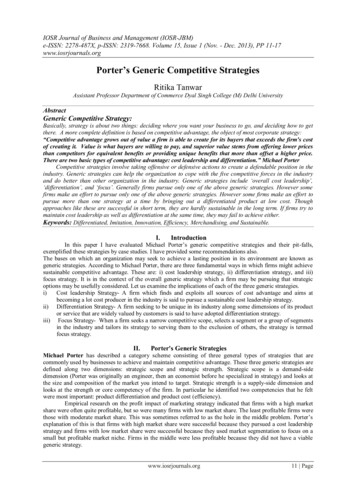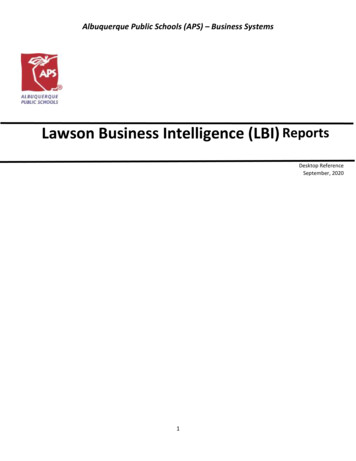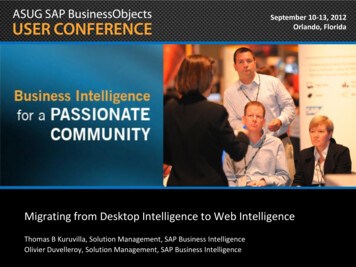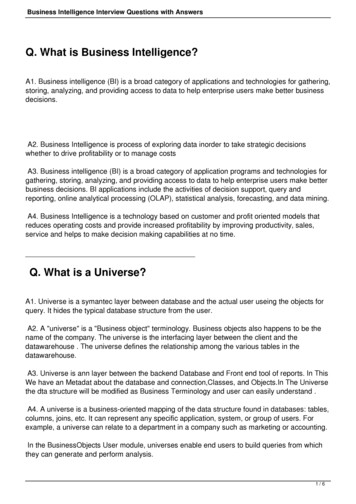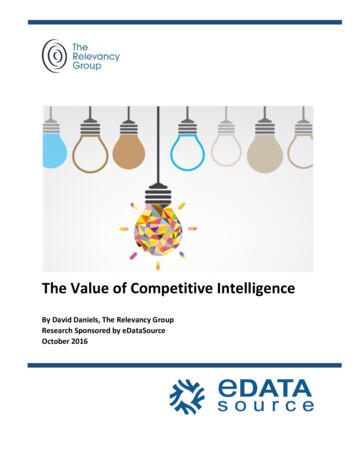
Transcription
The Value of Competitive IntelligenceBy David Daniels, The Relevancy GroupResearch Sponsored by eDataSourceOctober 2016
Executive OverviewBenchmarking one’s business against competitors is a time-tested and proven tactic to define gaps andidentify remedies to optimize against such weaknesses. Strength Weakness Opportunity Threat (SWOT)analysis is so common in business today, that it has been parodied for good reason in entertainment(e.g. the TV program ‘Silicon Valley’). While informative, the SWOT process isn’t nearly specific enoughto define which marketing levers need to be adjusted. Herein for the first time, we will define thecompetitive intelligence methods and document those that have a real impact on email marketingrevenue. Spoiler alert! Marketers must invest in Competitive Intelligence Applications (CIA), andimplement a systemic process to harness the value of such insight. While one-off projects and marketresearch methods can be helpful, they will not bring the same impact that providers of CIA can deliver.Marketers utilizing CIA enjoy 3x more monthly email revenue than marketers that do not invest in theseapplications.Marketers Must Place Greater Significance on Competitive Intelligence ApplicationsWatching one’s competitors is a tried and true aspect to running any business. From peaking over thefence to secret shopping, it has been an integral aspect of business operations for centuries. The toolsfor gathering this intelligence come in many forms. The Relevancy Group asked marketers to rate thesetools in a survey of 486 marketing executives conducted in the summer of 2016. We selected a handfulof email marketing competitive intelligence tactics and asked marketers to rate their importance (Figure1). Signing up for newsletters was rated as significantly important by 48% of marketers. In fact, itwas the top response in the survey. Newsletter sign-ups are easy and friction-free, that is, untilan intern or team member is tasked with putting the data into some unmanageable spreadsheetfor analysis. Marketers should throw away that chaotic spreadsheet and subscribe tocompetitors’ newsletters for a quick view into their world. But this alone will not drive anysubstantial competitive advantage. Analyst and market research services is the second most important tactic for marketers and forobvious reasons is a status I can appreciate. As someone that has been in the analyst/marketresearch industry for nearly 20 years, I know this tool is valuable but also that it typically onlyoffers a small glimpse or place in time view to competitors. For product-driven organizationswhere software may change annually, the learnings are typically cherished. But there are bettertools to measure something as fluid and frequent as email marketing offers. Use tools that provide performance and engagement data of my competitor’s email programs, amarket segment, which The Relevancy Group is formally referring to as Competitive IntelligenceApplications (CIA). This era of real-time data, contextual email and moment-marketing demandsa systemic programmatic approach to email marketing competitive intelligence. Only CIAproviders have the capability to hasten time to market and deliver near immediate optimizationopportunities. Forty percent of marketers state that they view CIA as significantly important,signaling that this market sector is about to move from nascent to mainstream in short order.These verticals are adopting CIA at a slightly greater rate than the overall market: Education(51%), Manufacturing (49%), Media/Publishing (43%). The other tactics as depicted in Figure 1 are all worthy too, but will not provide the insight andcompetitive measures that providers of CIA can deliver at scale.The Value of Competitive IntelligenceP a g e 1Copyright 2016 The Relevancy Group, LLC. All Rights Reserved.
Figure 1. Email Marketing Competitive Tactics Utilized – gning up fortheirnewsletters9%10%51%43%Analyst 6%Somewhat Important46%29%Use tools that Participate in Industry engagement and associationsreportsperformancedata of mycompetitor'semail marketingprogramsSignificantly Important27%27%Secret shopperDo Not Use, Not ImportantQuestion: From the following list please rate the importance of the following email marketing competitive tools/tactics that youutilize? (Select One for each) Source: The Relevancy Group Executive Survey n 486, 6/16 US Only.Competitive Intelligence is a Necessary Expense to Drive Email Marketing OptimizationIf you have not put aside budget for competitive intelligence endeavors you should. Why? Mostmarketers that invest in this endeavor spend 125,000.00 dollars annually. This approach across allformal and informal tasks may include things such as conferences, association and CIA investments.Clearly, marketers that are not investing in this area are likely to miss out on optimization opportunitiesand be left behind their competitors. The spending also indicates and underscores that this intelligenceis soon to move beyond emerging market sector to perennial budget item served by CIA providers. TheRelevancy Group has already documented the following spending trends: Large Senders – Those that are sending more than 60 million email messages a month arespending upwards of 225,000 annually on competitive intelligence. Market Size – On average those that identified as enterprise organizations (1,000 or moreemployees and/or market in the US and abroad) have an average annual competitiveintelligence budget of 150,000, as compared to their mid-market peers (fewer than 1,000employees and markets in the US) average annual budget of 94,000. Vertical – There are many ways to look at vertical adoption, but the Financial Services industryseems to be the most primed for competitive insight, as their average annual budget is 156,000. While Media/Publishing adoption is higher than others, their average budget is abouthalf of what it is for the Financial Services segment. These industry and market size differencesin spending are to be expected. (See Figures 2 and 3).With such impressive budget numbers and low upfront resource requirements, we expect to seecontinued investment into CIA providers in the next 12 to 16 months.The Value of Competitive IntelligenceP a g e 2Copyright 2016 The Relevancy Group, LLC. All Rights Reserved.
Figure 2. Annual Spending on Competitive Intelligence by Market Size – 2016Not Sure8%3%More than 500,0006%7%2%5% 100,001- 500,00014%22%19%25%25%25% 50,001- 100,00026% 10,001- 50,00038%31%8%Less than d-Market30%35%40%45%OverallQuestion: On an annual basis, how much do you spend on competitive intelligence? (Select One)Source: The Relevancy Group Executive Survey n 486, Mid-Market n 209, Enterprise n 277 6/16 US Only.Figure 3. Annual Spending on Competitive Intelligence by Industry – 20168%6%7%Not SureMore than 500,00011%3%3%07%6% 100,001- 500,0009%11%26%20%27% 50,001- 100,00034%23%24% 10,001- 50,000Less than 5%40%Financial ServicesQuestion: On an annual basis, how much do you spend on competitive intelligence? (Select One)Source: The Relevancy Group Executive Survey n 486,Financial Services n 70, Media/Publishing n 35, Retail n 63, Travel n 35 6/16 US Only.The Value of Competitive IntelligenceP a g e 3Copyright 2016 The Relevancy Group, LLC. All Rights Reserved.
Tremendous Demand Exists For Competitive Intelligence ApplicationsWhen asked specifically if they would use a tool that allowed the marketer to view their competitors’email, including performance data, just over one third (38 percent) stated that they are already utilizingsuch an application. Such adoption of CIAs signals an established ecosystem that is buoyed by theadditional 52 percent of marketers that stated that they would use such an application (Figure 4). Thefavorable adoption rates and marketer aspiration for such a tool makes sense: who wouldn’t want theircompetitors’ Key Performance Indicators (KPIs) and email creative to benchmark against their own? Therate of CIA adoption will make a difference, as we believe it will have a significant competitive andrevenue impact – a hypothesis that we document in this research. But before we get into those returnnumbers, what are the general benefits that you the marketer should seek when shopping for CIAs? Tracking Actionable Capabilities – What is trackable and actionable? Measure against othersenders using attributes such as time of day, subject word performance, frequencymeasurement and automation that alerts the marketer and allows for customization. Measure and Optimize Inbox Placement – Email optimization begins with getting things into theinbox. Delivery services help, and so does list quality, but here it is important how those deliverymeasures can be utilized to optimize the overall email marketing plan. And about six other things – Email optimization is so necessary, we suggest a six-point vendorselection process (Figure 5).Figure 4 – Utilization of Competitive Intelligence Applications (CIA)10%38%52%Yes, we currently use an application, i.e. eDataSource, ReturnPathYes, we would use itNoQuestion: If a tool existed that allowed you to view your competitors email performance data including open rate, click-through rate anddelivery rate, would use it? (Select One) Source: The Relevancy Group Executive Survey n 486, 6/16 US Only.The Value of Competitive IntelligenceP a g e 4Copyright 2016 The Relevancy Group, LLC. All Rights Reserved.
Selecting the Right CIA Provider Demands a Rigorous Vendor EvaluationAll things are not similar in this growing ecosystem. Accordingly, we believe there are six major areasthat any prospective CIA buyer must thoroughly evaluate (Figure 5).1. What is the source of the panel data? Investigate how the CIA is amassing their competitivedata at the source. In comparison is it spring water or filtered water that makes up this bottledwater? Meaning, ask how they get their data and how representative it is of ISPs anddemographics that might matter to you.2. How does that source align to your industry and competitors? This is where things can quicklyfall apart, particularly if you are a niche retailer or specialized boutique. It is also the placewhere some CIA vendors will rise to the moment and detail their coverage of your industry andyour specific competitors.3. What are the custom reporting capabilities? While most CIA vendors offer some stock reportsabout basic KPIs, marketers often transcend those rules and measures quickly. Investigate ifyour prospective CIA vendor has custom reporting capabilities and how those items are includedin the agreement. For those that need services, expertise begins to matter immensely.4. What can be automated, saved, reused and altered? There is so much one-off in the marketingcloud world, so make sure your CIA can save things for future re-use. Items such as X Competitorand Y dates or Z offers. When things change, will you be alerted? How much can be automatedso that you can begin to utilize these tools in a competitive intelligence lifecycle. If it can’t be,then ask when it can be.5. Does their services team include email marketing experts? This is huge, in that the insight thatmay be discovered in the CIA translates immediately into findings, some of which may requireexternal services expertise to decipher. Often CIA tools emerge from delivery or only inboxplacement experts. While that is welcome, ensure you understand the services fees, especially ifthe vendor plans to boot you to a “marketing expert partner” for a fee.6. How easy is the application to use? Time is money and some CIA applications are so easy to usethat they only require an hour of training. Ensure you keep usability in mind. While ease-of-useis in the eye of the beholder, it has lasting benefit or penalty for the marketer’s time, particularlywhen that time is money.Figure 5 – CIA Selection Criteria QuestionsSource: The Relevancy Group, 10/16The Value of Competitive IntelligenceP a g e 5Copyright 2016 The Relevancy Group, LLC. All Rights Reserved.
Competitive Intelligence Applications are Key to Driving KPI ImprovementsMore than one third of companies that utilize CIA recognized KPI improvements (Figure 6). Some of thebenefits cited include: Improved Open Rates: When one begins to utilize competitive insight and see peer emails, itemssuch as subject lines can be evaluated and leveraged as a mechanism to improve open rates. Improved Understanding of Optimal Message Frequency: From nearly 30 years of experience inmarketing, my question is how many? Which day? The answer is test. But imagine if you knowyour competitors’ cadence, might that only help or be an interesting input? Improved Click-Through: The ability to optimize the offer and deliver content with competitiveknowledge helps marketers improve response rates. Thirty-three percent of these CIA marketersare reaping engagement benefits. Improved Understanding of What Works for Our Competitors: This might be a bi-directionallooking glass. If your brand is in a highly competitive space, your competitor might be looking atyour work. In love so is war, so why not trial CIA tools to understand what is working for yourcompetitors. Thirty-three percent of marketers cite understanding the competition as a CIAbenefit (Figure 6).Figure 6 - Improvements from Utilizing a Competitive Intelligence Application (CIA)Improved open rates34%Improved our understanding of optimal messagefrequency34%Improved click-through rates33%Improved our understanding of what works for ourcompetitors33%Improved average order value33%Improved deliverability, inbox placement32%Improved forward/social sharing rates31
for analysis. Marketers should throw away that chaotic spreadsheet and subscribe to competitors’ newsletters for a quick view into their world. But this alone will not drive any substantial competitive advantage. Analyst and market research services is the second most
![05[2] Strategy competitors, competitive rivalry .](/img/2/052-strategy-competitors-competitive-rivalry-competitive-behavior-and-competitive-dynamics.jpg)
